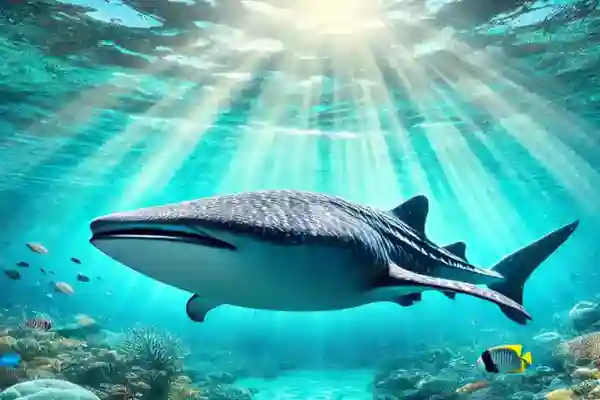Marine Life Koh Chang – What Can You See While Diving?
Discover Koh Chang's dive sites, vibrant coral reefs and underwater creatures. We offer daily diving and snorkelling trips to the most popular sites in Mu Koh Chang National Park.
There are about 21,000 species of fish on our planet. To classify them, we look at key characteristics like shape, colour, and size. During our dives – whether you're doing a Try Dive or a course – we move slowly along the reef to observe and document.
At our wrecks and reef sites we encounter many different fish families. If we can't identify a species, we sketch it or use marine ID books. It's important for divers and snorkelers to observe changes and report them – that's how we protect this fragile ecosystem.
To support your learning, we've compiled an overview of marine life in Koh Chang – and you can even get your own ID slate in our store!
🧭 Ready to Explore Koh Chang's Underwater World?
Join us for Fun Dives or Diving Courses and discover the vibrant marine life of Koh Chang. All gear is provided – or check out our diving equipment if you want your own!
Marine Mammals in Koh Chang
| Image | Name | Details |
|---|---|---|
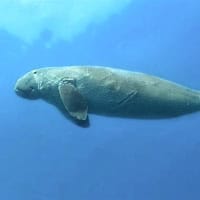
|
Dugong Dugon |
SIZE: 4 m RARITY: Rare BEHAVIOR: Indifferent AGE: 73 Years |
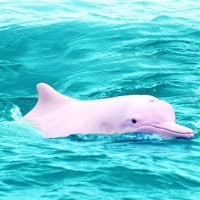
|
Chinese White Dolphin |
SIZE: 3.2 m RARITY: Uncommon BEHAVIOR: Fearful AGE: 50 Years |

|
Irrawaddy Dolphin |
SIZE: 2.8 m RARITY: Rare BEHAVIOR: Curious AGE: 28 Years |
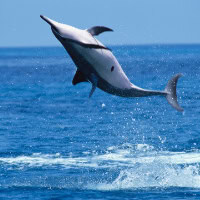
|
Spinner Dolphin |
SIZE: 2.4 m RARITY: Uncommon BEHAVIOR: Fearful AGE: 50 Years |
Sharks & Rays
Sharks and rays are some of the most enigmatic and misunderstood creatures of the ocean. They are crucial for the health of our planet. Sharks and rays help the world, from fighting climate change to sharing food with their neighbors to growing phytoplankton.
| Image | Name | Details |
|---|---|---|
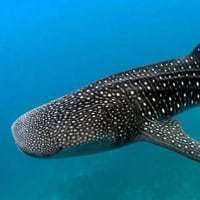
|
Whale Shark |
SIZE: 18 m RARITY: Rare BEHAVIOR: Indifferent AGE: 100 Years |
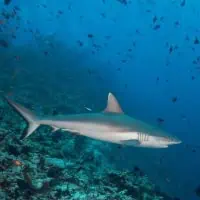
|
Grey Reef Shark |
SIZE: 2.6 m RARITY: Common BEHAVIOR: Curious AGE: 25 Years DANGEROUS: Bite |
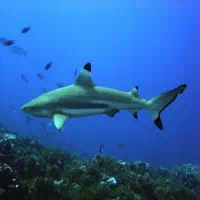
|
Blacktip Reef Shark |
SIZE: 2 m RARITY: Uncommon BEHAVIOR: Curious AGE: 12 Years DANGEROUS: Bite |
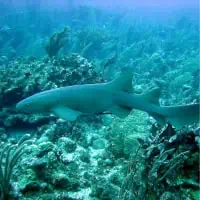
|
Tawny Nurse Shark |
SIZE: 3.2 m RARITY: Uncommon BEHAVIOR: Curious DANGEROUS: Bite |
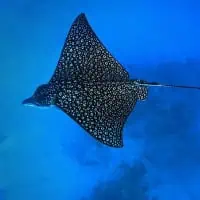
|
Eagle Ray |
SIZE: 1.5 m RARITY: Rare BEHAVIOR: Indifferent |
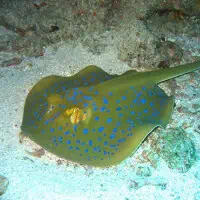
|
Blue Spotted Maskray |
SIZE: 0.7 m RARITY: Rare BEHAVIOR: Indifferent |
Crevalle jack
The crevalle jack (Caranx hippos), also known as the common jack, black-tailed trevally, couvalli jack, black cavalli, jack crevale, or yellow cavalli is a common species of large marine fish classified within the jack family, Carangidae. The crevalle jack is distributed across the tropical and temperate waters
| Image | Name | Details |
|---|---|---|
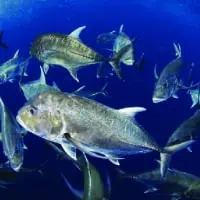
|
Giant Trevally |
SIZE: 1.7 m RARITY: Rare BEHAVIOR: Fearful AGE: 20 Years |
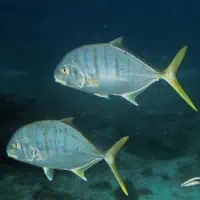
|
Golden Trevally |
SIZE: 1.2 m RARITY: Uncommon BEHAVIOR: Curious AGE: 20 Years |
Batfishes & Coastal Fishes
Coastal fish, also called inshore fish or neritic fish, inhabit the sea between the shoreline and the edge of the continental shelf. Since the continental shelf is usually less than 200 metres deep, it follows that pelagic coastal fish are generally epipelagic fish, inhabiting the sunlit epipelagic zone. Coastal fish can be contrasted with oceanic fish or offshore fish, which inhabit the deep seas beyond the continental shelves.
| Image | Name | Details |
|---|---|---|
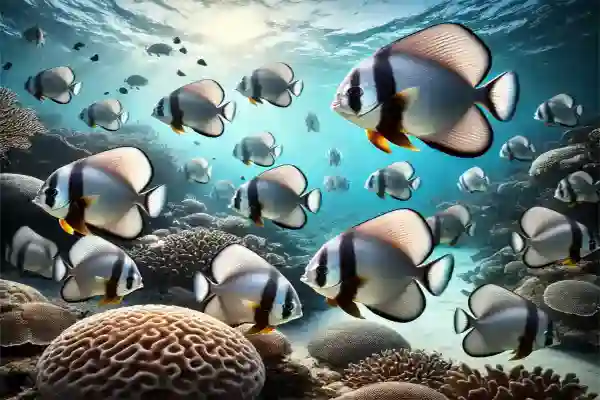
|
Longfin Batfish |
SIZE: 0.7 m RARITY: Uncommon BEHAVIOR: Curious |
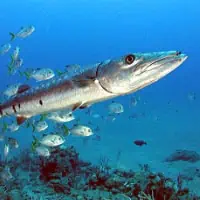
|
Great Barracuda |
SIZE: 1.7 m RARITY: Uncommon BEHAVIOR: Indifferent DANGEROUSNESS: Bite |
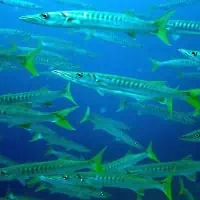
|
Yellowtail Barracuda |
SIZE: 1.4 m RARITY: Uncommon BEHAVIOR: Curious |
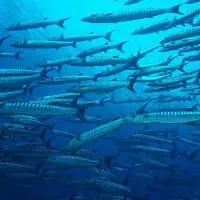
|
Chevron Barracuda |
SIZE: 1.2 m RARITY: Uncommon BEHAVIOR: Indifferent |
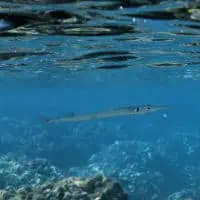
|
Keeltail Needlefish |
SIZE: 0.6 m RARITY: Common BEHAVIOR: Fearful |
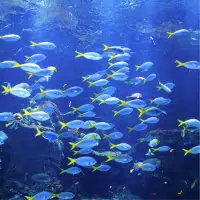
|
Redbelly Yellowtail Fusilier |
SIZE: 0.6 m RARITY: Uncommon BEHAVIOR: Fearful |
Coral Reef Fish's
Coral reef fish are fish which live amongst or in close relation to coral reefs. Coral reefs form complex ecosystems with tremendous biodiversity. Among the myriad inhabitants, the fish stand out as colourful and interesting to watch. Hundreds of species can exist in a small area of a healthy reef, many of them hidden or well camouflaged. Reef fish have developed many ingenious specialisations adapted to survival on the reefs.
| Image | Name | Details |
|---|---|---|
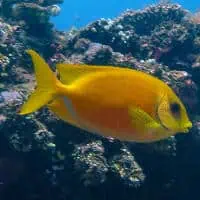
|
Coral Rabbitfish |
SIZE: 0.4 m RARITY: Uncommon BEHAVIOR: Indifferent |
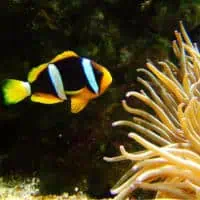
|
Clark's Anemonefish |
SIZE: 0.15 m RARITY: Common BEHAVIOR: Indifferent AGE: 14 Years |
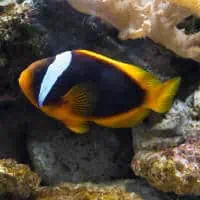
|
Fire Clownfish |
SIZE: 0.15 m RARITY: Common BEHAVIOR: Indifferent |
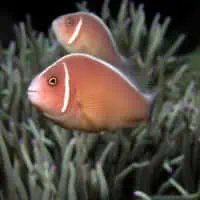
|
Skunk Clownfish |
SIZE: 0.15 m RARITY: Common BEHAVIOR: Indifferent AGE: 14 Years |
Damselfishes
Damselfishes comprise the family Pomacentridae except those of the genera Amphiprion and Premnas, which are the anemonefishes. The largest can grow up to 36 cm (14 in) long, but most species are much smaller. While most are marine, a few species inhabit the lower stretches of rivers in fresh water. Most damselfish species have bright colors or strongly contrasting patterns.
| Image | Name | Details |
|---|---|---|
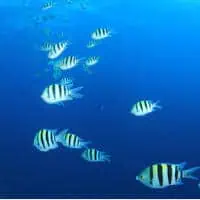
|
Scissortail Sergeant |
SIZE: 0.2 m RARITY: Plentiful BEHAVIOR: Indifferent |
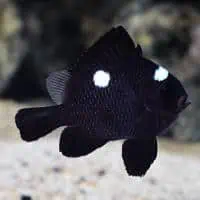
|
Domino Damselfish |
SIZE: 0.14 m RARITY: Uncommon BEHAVIOR: Aggressive |
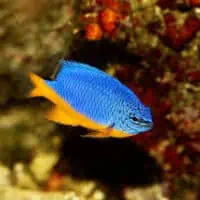
|
Sapphire Damsel |
SIZE: 0.11 m RARITY: Uncommon BEHAVIOR: Indifferent |
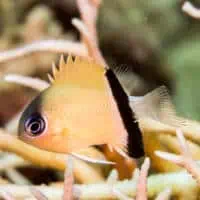
|
Black-bar Chromis |
SIZE: 0.06 m RARITY: Uncommon BEHAVIOR: Fearful |
Anthias and Cardinalfishes
Cardinalfishes are a family, Apogonidae, of ray-finned fishes found in the Atlantic, Indian, and Pacific Oceans; they are chiefly marine, but some species are found in brackish water and a few (notably Glossamia) are found in fresh water. A handful of species are kept in the aquarium and are popular as small, peaceful, and colourful fish. The family includes about 370 species.
| Image | Name | Details |
|---|---|---|
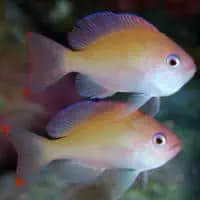
|
Stocky Anthias |
SIZE: 0.2 m RARITY: Plentiful BEHAVIOR: Indifferent |
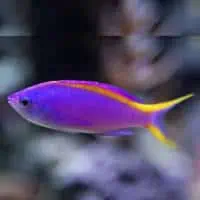
|
Purple Anthis |
SIZE: 0.12 m RARITY: Common BEHAVIOR: Indifferent |
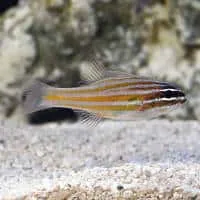
|
Yellow-striped Cardinalfish |
SIZE: 0.11 m RARITY: Uncommon BEHAVIOR: Indifferent |
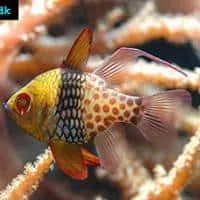
|
Pajama Cardinalfish |
SIZE: 0.08 m RARITY: Rare BEHAVIOR: Indifferent |
Squirrelfishes
The squirrelfish is a silvery red, sea fish with orange-gold body stripes. There are about 150 species of squirrelfish, their most distinguishing characteristics are their large eyes and the long third spine of the anal fin. It lives in coral reefs in tropical and warm temperate seas and eats zoobenthos.
| Image | Name | Details |
|---|---|---|
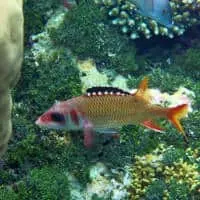
|
Blackfin Squirrelfish |
SIZE: 0.35 m RARITY: Uncommon BEHAVIOR: Indifferent |
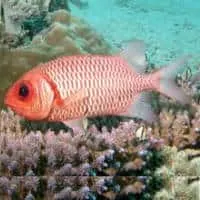
|
Doubletooth Soldierfish |
SIZE: 0.3 m RARITY: Common BEHAVIOR: Indifferent |
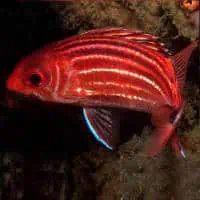
|
Threespot Squirrelfish |
SIZE: 0.27 m RARITY: Common BEHAVIOR: Indifferent |
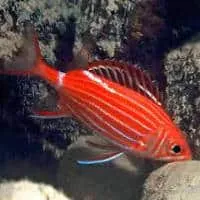
|
Crown Squirrelfish |
SIZE: 0.17 m RARITY: Common BEHAVIOR: Indifferent |
Wrasses
The wrasses are a family, Labridae, of marine fish, many of which are brightly colored. The family is large and diverse, with over 600 species in 81 genera, which are divided into 9 subgroups or tribes. They are typically small fish, most of them less than 20 cm long, although the largest, the humphead wrasse, can measure up to 2.5 m. They are efficient carnivores, feeding on a wide range of small invertebrates.
| Image | Name | Details |
|---|---|---|
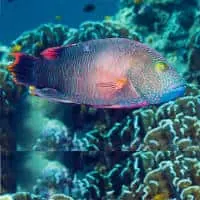
|
Tripletail Wrasse |
SIZE: 0.45 m RARITY: Uncommon BEHAVIOR: Fearful |
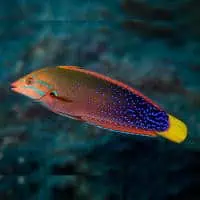
|
African Coris |
SIZE: 0.4 m RARITY: Uncommon BEHAVIOR: Fearful |
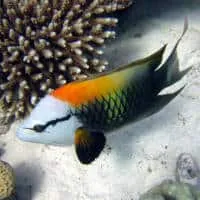
|
Sling-jaw Wrasse |
SIZE: 0.54 m RARITY: Common BEHAVIOR: Indifferent |
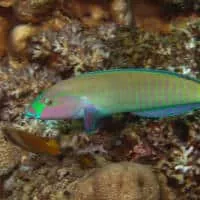
|
Pastel Ringwrasse |
SIZE: 0.5 m RARITY: Uncommon BEHAVIOR: Fearful |
Snappers
Snappers are a family of perciform fish, Lutjanidae, mainly marine, but with some members inhabiting estuaries, feeding in fresh water. The family includes about 113 species. Some are important food fish. One of the best known is the red snapper.
| Image | Name | Details |
|---|---|---|
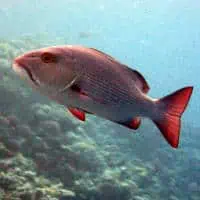
|
Emperor Red Snapper |
SIZE: 1.16 m RARITY: Uncommon BEHAVIOR: Fearful AGE: 35 Years |
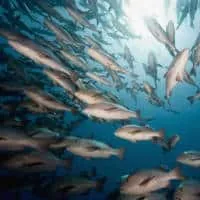
|
Mangrove Red Snapper |
SIZE: 1.2 m RARITY: Uncommon BEHAVIOR: Fearful AGE: 35 Years |
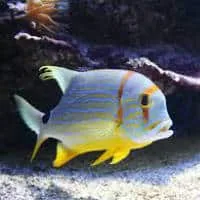
|
Sailfin Snapper |
SIZE: 0.6 m RARITY: Rare BEHAVIOR: Indifferent |
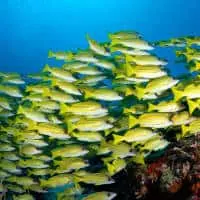
|
Bluestripe Snapper |
SIZE: 0.4 m RARITY: Common BEHAVIOR: Indifferent |
Sweetlips
Plectorhinchus chaetodonoides, the harlequin sweetlips, is a species of grunt native to the Indian Ocean and the western Pacific Ocean. It is a denizen of coral reefs found at depths of from 1 to 30 m.
| Image | Name | Details |
|---|---|---|
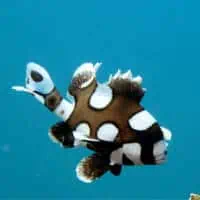
|
Harlequin Sweetlips |
SIZE: 0.7 m RARITY: Uncommon BEHAVIOR: Indifferent |
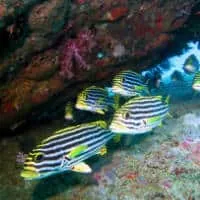
|
Oriental Sweetlips |
SIZE: 0.7 m RARITY: Common BEHAVIOR: Indifferent |
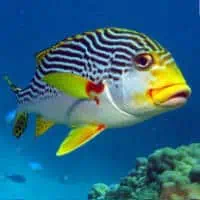
|
Yellowbanded Sweetlips |
SIZE: 0.7 m RARITY: Common BEHAVIOR: Indifferent |
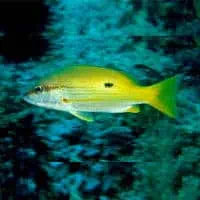
|
Dory Snapper |
SIZE: 0.35 m RARITY: Common BEHAVIOR: Indifferent AGE: 23 Years |
Emperors
The Lethrinidae are a family of fishes in the order Perciformes commonly known as emperors, emperor breams, and pigface breams. These fish are found in tropical waters of the Pacific and Indian Oceans, and Lethrinus atlanticus is also found in the eastern Atlantic Ocean.
| Image | Name | Details |
|---|---|---|
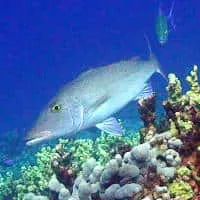
|
Longface Emporor |
SIZE: 1.00 m RARITY: Uncommon BEHAVIOR: Fearful |
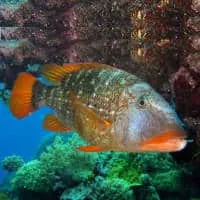
|
Sweetlip Emporor |
SIZE: 0.90 m RARITY: Uncommon BEHAVIOR: Fearful |
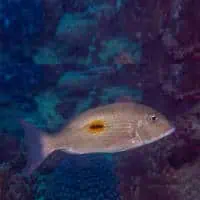
|
Thumbprint Emporor |
SIZE: 0.50 m RARITY: Uncommon BEHAVIOR: Fearful AGE: 15 Years |
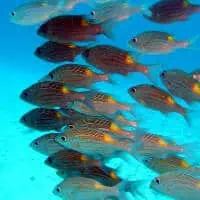
|
Striped large-eye bream |
SIZE: 0.30 m RARITY: Common BEHAVIOR: Indifferent |
Soapfishes and Dottybacks
The Serranidae (Soapfishes and Dottybacks) are a large family of fishes belonging to the order Perciformes. The family contains about 450 species in 65 genera, including the sea basses and the groupers (subfamily Epinephelinae).
| Image | Name | Details |
|---|---|---|
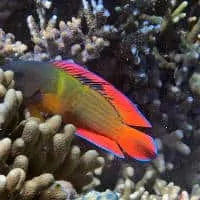
|
Firetail Dottyback |
SIZE: 0.20 m RARITY: Uncommon BEHAVIOR: Fearful |
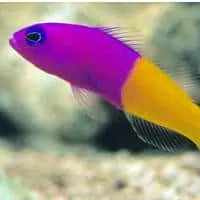
|
Royal Dottyback |
SIZE: 0.07 m RARITY: Common BEHAVIOR: Indifferent |
Groupers
The Serranidae are a large family of fishes belonging to the order Perciformes. The family contains about 450 species in 65 genera, including the sea basses and the groupers (subfamily Epinephelinae). Although many species are small, in some cases less than 10 cm, the giant grouper (Epinephelus lanceolatus) is one of the largest bony fishes in the world, growing to 2.7 m in length and 400 kg in weight. Representatives of this group live in tropical and subtropical seas worldwide.
| Image | Name | Details |
|---|---|---|
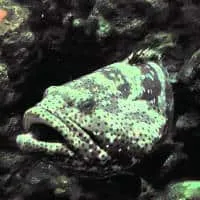
|
Brown-marbled Grouper |
SIZE: 1.20 m RARITY: Rare BEHAVIOR: Indifferent |
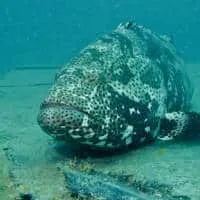
|
Malabar Grouper |
SIZE: 1.20 m RARITY: Uncommon BEHAVIOR: Fearful AGE: 32 Years |
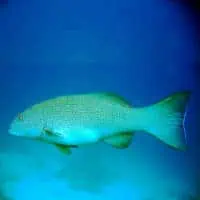
|
Highfin Coralgrouper |
SIZE: 0.75 m RARITY: Rare BEHAVIOR: Indifferent |
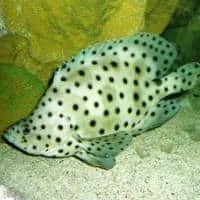
|
Humpback Grouper |
SIZE: 0.70 m RARITY: Rare BEHAVIOR: Fearful |
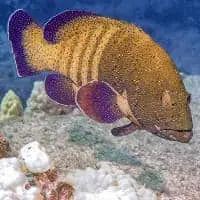
|
Peacock hind |
SIZE: 0.75 m RARITY: Rare BEHAVIOR: Fearful |
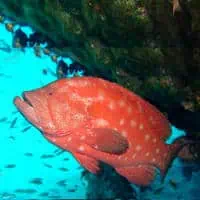
|
Tomato hind |
SIZE: 0.58 m RARITY: Uncommon BEHAVIOR: Indifferent |
Angelfish
Marine angelfish are perciform fish of the family Pomacanthidae. They are found on shallow reefs in the tropical Atlantic, Indian, and mostly western Pacific Oceans. The family contains seven genera and about 86 species. They should not be confused with the freshwater angelfish, tropical cichlids of the Amazon Basin.
| Image | Name | Details |
|---|---|---|
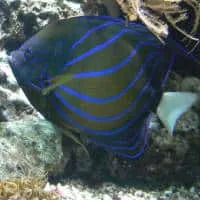
|
Bluering Angelfish |
SIZE: 0.45 m RARITY: Rare BEHAVIOR: Indifferent |
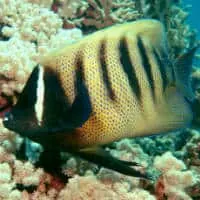
|
Sixbar Angelfish |
SIZE: 0.45 m RARITY: Uncommon BEHAVIOR: Fearful |
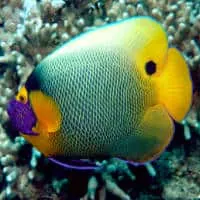
|
Yellowface Angelfish |
SIZE: 0.38 m RARITY: Rare BEHAVIOR: Fearful |
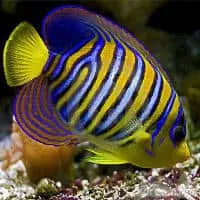
|
Royal Angelfish |
SIZE: 0.25 m RARITY: Uncommon BEHAVIOR: Indifferent AGE: 15 Years |
Butterflyfishes
The butterflyfish are a group of conspicuous tropical marine fish of the family Chaetodontidae; the bannerfish and coralfish are also included in this group. The approximately 129 species in 12 genera[1] are found mostly on the reefs of the Atlantic, Indian, and Pacific Oceans. A number of species pairs occur in the Indian and Pacific Oceans, members of the huge genus Chaetodon.
| Image | Name | Details |
|---|---|---|
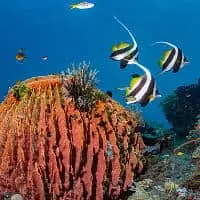
|
Pennant Coralfish |
SIZE: 0.25 m RARITY: Common BEHAVIOR: Indifferent |
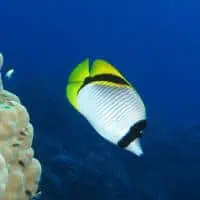
|
Lined Butterflyfish |
SIZE: 0.30 m RARITY: Rare BEHAVIOR: Fearful AGE: 10 Years |
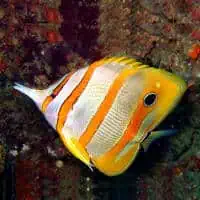
|
Chopperband Butterflyfish |
SIZE: 0.38 m RARITY: Rare BEHAVIOR: Fearful |
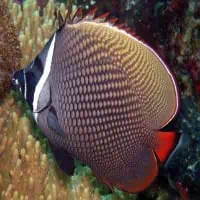
|
Redtail Butterflyfish |
SIZE: 0.18 m RARITY: Uncommon BEHAVIOR: Indifferent |
Parrotfishes
Parrotfishes are a group of about 95 fish species regarded as a family (Scaridae), or a subfamily (Scarinae) of the wrasses. With about 95 species, this group's largest species richness is in the Indo-Pacific. They are found in coral reefs, rocky coasts, and seagrass beds, and can play a significant role in bioerosion.
| Image | Name | Details |
|---|---|---|
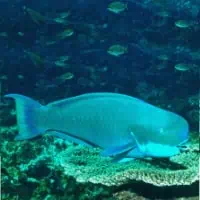
|
Steephead Parrotfish |
SIZE: 0.70 m RARITY: Uncommon BEHAVIOR: Indifferent |
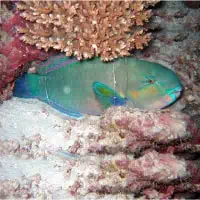
|
Daisy Parrotfish |
SIZE: 0.40 m RARITY: Common BEHAVIOR: Indifferent |
Triggerfishes
Triggerfishes are about 40 species of often brightly colored fish of the family Balistidae. Often marked by lines and spots, they inhabit tropical and subtropical oceans throughout the world, with the greatest species richness in the Indo-Pacific. Most are found in relatively shallow, coastal habitats, especially at coral reefs, but a few, such as the oceanic triggerfish (Canthidermis maculata), are pelagic. While several species from this family are popular in the marine aquarium trade, they are often notoriously ill-tempered.
| Image | Name | Details |
|---|---|---|
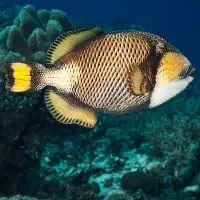
|
Titan Triggerfish |
SIZE: 0.85 m RARITY: Common BEHAVIOR: Aggressive |
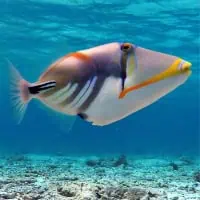
|
Picasso Triggerfish |
SIZE: 0.30 m RARITY: Uncommon BEHAVIOR: Aggressive |
Filefishes
The filefish (Monacanthidae) are a diverse family of tropical to subtropical tetraodontiform marine fish, which are also known as foolfish, leatherjackets or shingles. They live in the Atlantic, Pacific and Indian Oceans. Filefish are closely related to the triggerfish, pufferfish and trunkfish.
| Image | Name | Details |
|---|---|---|
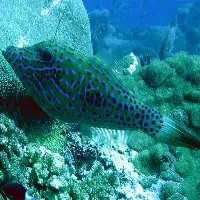
|
Scrawled Filefish |
SIZE: 1.10 m RARITY: Uncommon BEHAVIOR: Fearful |
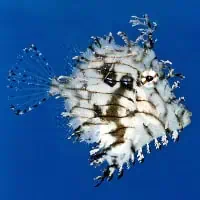
|
Prickly Leatherjacket |
SIZE: 0.31 m RARITY: Rare BEHAVIOR: Indifferent |
Pufferfishes
The Tetraodontidae are a family of primarily marine and estuarine fish of the order Tetraodontiformes. The family includes many familiar species which are variously called pufferfish, puffers, balloonfish, blowfish, blowies, bubblefish, globefish, swellfish, toadfish, toadies, honey toads, sugar toads, and sea squab.
| Image | Name | Details |
|---|---|---|
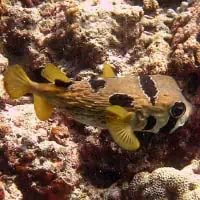
|
Black-blothed Porcupinefish |
SIZE: 0.65 m RARITY: Uncommon BEHAVIOR: Indifferent |
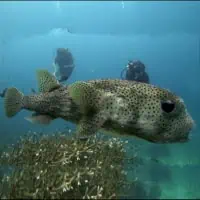
|
Blackspotted Pufferfish |
SIZE: 0.33 m RARITY: Common BEHAVIOR: Indifferent |
Goatfishes and other bottom Fishes
Goatfishes are characterized by a pair of chin barbels (or "goatee"), which contain chemosensory organs and are used to probe the sand or holes in the reef for food. Their bodies are deep and elongated, with forked tails and widely separated dorsal fins.
| Image | Name | Details |
|---|---|---|
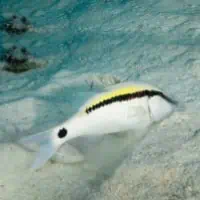
|
Dash-and-Dot Goatfish |
SIZE: 0.60 m RARITY: Common BEHAVIOR: Indifferent |
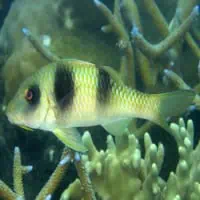
|
Doublebar Goatfish |
SIZE: 0.35 m RARITY: Common BEHAVIOR: Indifferent |
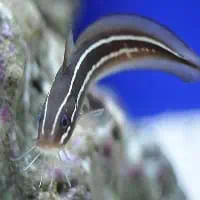
|
Striped eel Catfish |
SIZE: 0.32 m RARITY: Uncommon BEHAVIOR: Indifferent DANGEROUSNESS: Lethal |
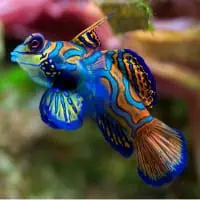
|
Mandarinfish |
SIZE: 0.07 m RARITY: Common BEHAVIOR: Indifferent |
Lengthened & Strange Fishes
The pipefish is widespread throughout the tropical waters of the Indo-Pacific region, Red Sea included. Its range includes Australia, Fiji, French Polynesia, Indonesia, Japan, the Marshall Islands, New Caledonia, Northern Mariana Islands, Papua New Guinea, the Philippines, Samoa, the Solomon Islands, South Africa, and Taiwan. It inhabits tide pools, lagoons, and outer reef slopes in tropical climates.
Seahorses range in size from 1.5 to 35.5 cm. They are named for their equine appearance, with bent necks and long snouted heads and a distinctive trunk and tail. Although they are bony fish, they do not have scales, but rather thin skin stretched over a series of bony plates, which are arranged in rings throughout their bodies.
| Image | Name | Details |
|---|---|---|
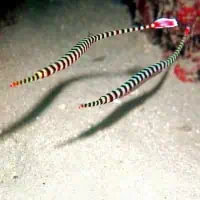
|
Ringed Pipefish |
SIZE: 0.19 m RARITY: Rare BEHAVIOR: Indifferent AGE: 10 Years |
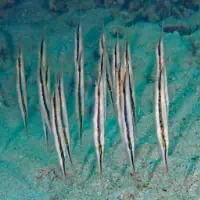
|
Grooved Razor-fish |
SIZE: 0.15 m RARITY: Uncommon BEHAVIOR: Indifferent |
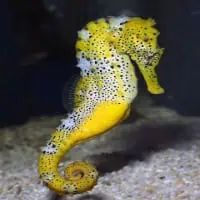
|
Spotted Seahorse |
SIZE: 0.30 m RARITY: Rare BEHAVIOR: Indifferent |
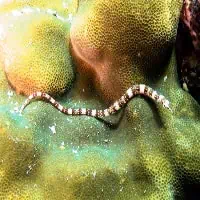
|
Brown-banded Pipefish |
SIZE: 0.10 m RARITY: Rare BEHAVIOR: Indifferent |
Blennies and Gobies
Generally benthic fish, blennies spend much of their time on or near the bottom. They may inhabit the rocky crevices of reefs, burrows in sandy or muddy substrates, or even empty shells. Generally found in shallow waters, some combtooth blennies are capable of leaving the water for short periods during low tide, aided by their large pectoral fins which act as "feet". Small benthic crustaceans, mollusks, and other sessile invertebrates are the primary food items for most species; others eat algae or plankton.
| Image | Name | Details |
|---|---|---|
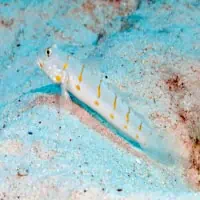
|
Maiden Goby |
SIZE: 0.20 m RARITY: Common BEHAVIOR: Indifferent |
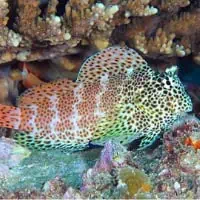
|
Leopard Blenny |
SIZE: 0.15 m RARITY: Uncommon BEHAVIOR: Fearful |
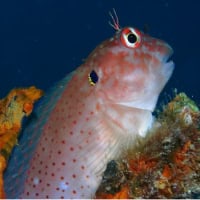
|
Blackflap Blenny |
SIZE: 0.30 m RARITY: Rare BEHAVIOR: Indifferent |
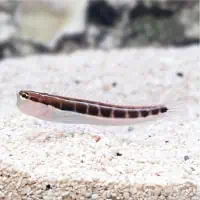
|
Linear Blenny |
SIZE: 0.09 m RARITY: Uncommon BEHAVIOR: Indifferent |
Lizardfishes
Lizardfishes are generally small, although the largest species measures about 60 cm in length. They have slender, somewhat cylindrical bodies, and heads that superficially resemble those of lizards. The dorsal fin is located in the middle of the back, and accompanied by a small adipose fin placed closer to the tail. They have mouths full of sharp teeth, even on the tongue.
| Image | Name | Details |
|---|---|---|
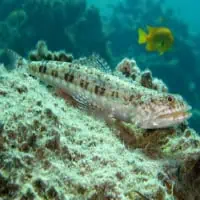
|
Variegated Lizardfish |
SIZE: 0.40 m RARITY: Common BEHAVIOR: Indifferent |
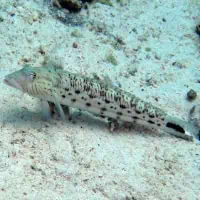
|
Speckled Sandperch |
SIZE: 0.30 m RARITY: Common BEHAVIOR: Indifferent |
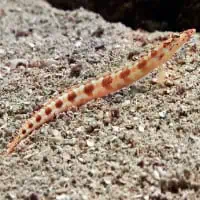
|
Spotted Sand-diver |
SIZE: 0.22 m RARITY: Uncommon BEHAVIOR: Fearful |
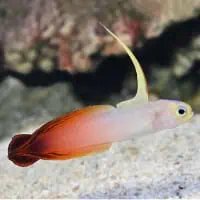
|
Fire Goby |
SIZE: 0.09 m RARITY: Common BEHAVIOR: Fearful |
Scorpionfishes
The Scorpionfishes (Scorpaeniformes) are a diverse order of ray-finned fish, including the lionfish, but have also been called the Scleroparei. It is one of the five largest orders of bony fishes by number of species, with over 1,320. They are known as "mail-cheeked" fishes due to their distinguishing characteristic, the suborbital stay: a backwards extension of the third circumorbital bone (part of the lateral head/cheek skeleton, below the eye socket) across the cheek to the preoperculum, to which it is connected in most species
| Image | Name | Details |
|---|---|---|
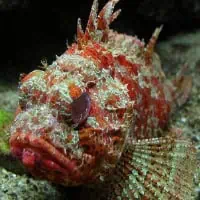
|
Scorpaena Scrofa (Dragon-head) |
SIZE: 0.30 m RARITY: Common BEHAVIOR: Indifferent DANGEROUSNESS: Spines / Lethal |
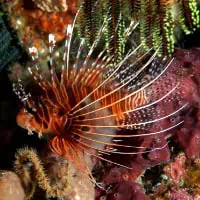
|
Broadbarred Firefish |
SIZE: 0.20 m RARITY: Uncommon BEHAVIOR: Indifferent DANGEROUSNESS: Spines / Lethal |
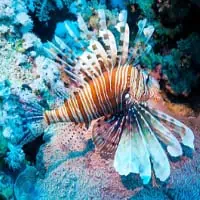
|
Red Lionfish |
SIZE: 0.40 m RARITY: Common BEHAVIOR: Indifferent DANGEROUSNESS: Spines / Lethal |
Reptiles
Reptiles are tetrapod animals in the class Reptilia, comprising today's turtles, crocodilians, snakes, amphisbaenians, lizards, tuatara, and their extinct relatives. The study of these traditional reptile orders, historically combined with that of modern amphibians, is called herpetology.
| Image | Name | Details |
|---|---|---|
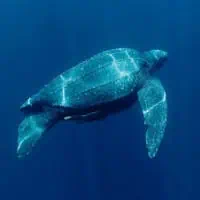
|
Leatherback Turtle |
SIZE: 2.00 m RARITY: Rare BEHAVIOR: Indifferent |
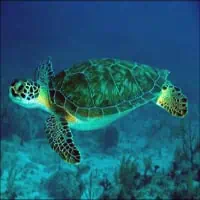
|
Green Turtles |
SIZE: 1.20 m RARITY: Uncommon BEHAVIOR: Indifferent |
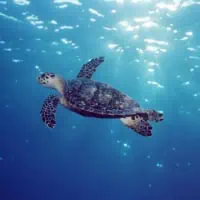
|
Hawksbill Turtle |
SIZE: 1.00 m RARITY: Uncommon BEHAVIOR: Fearful |
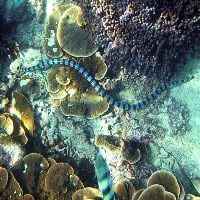
|
Blue-lipped Sea Krait |
SIZE: 1.10 m RARITY: Rare BEHAVIOR: Indifferent DANGEROUSNESS: Lethal |
Shrimps
Shrimps play important roles in the food chain and are an important food source for larger animals ranging from fish to whales. The muscular tails of many shrimp are edible to humans, and they are widely caught and farmed for human consumption. Commercial shrimp species support an industry worth 50 billion dollars a year, and in 2010 the total commercial production of shrimp was nearly 7 million tonnes.
| Image | Name | Details |
|---|---|---|
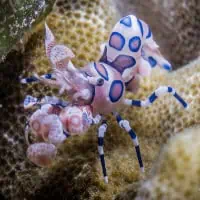
|
Harlequin Shrimp |
SIZE: 0.05 m RARITY: Rare BEHAVIOR: Fearful |
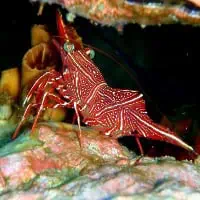
|
Dancing shrimp |
SIZE: 0.05 m RARITY: Uncommon BEHAVIOR: Indifferent |
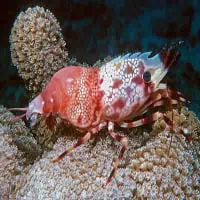
|
Pine-cone-marbled shrimp |
SIZE: 0.04 m RARITY: Rare BEHAVIOR: Indifferent |
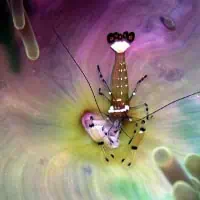
|
Peacock-tail anemone shrimp |
SIZE: 0.04 m RARITY: Common BEHAVIOR: Indifferent |
Crabs
Crabs are generally covered with a thick exoskeleton, composed primarily of highly mineralized chitin, and armed with a single pair of chelae (claws). Crabs are found in all of the world's oceans, while many crabs live in fresh water and on land, particularly in tropical regions. Crabs vary in size from the pea crab, a few millimeters wide, to the Japanese spider crab, with a leg span up to 4 m.
| Image | Name | Details |
|---|---|---|
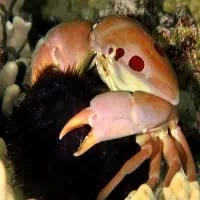
|
Spotted-Reef Crab |
SIZE: 0.17 m RARITY: Uncommon BEHAVIOR: Indifferent |
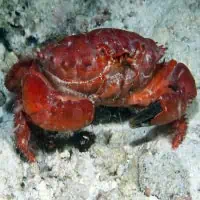
|
Splendid-Pebble Crab |
SIZE: 0.15 m RARITY: Uncommon BEHAVIOR: Indifferent |
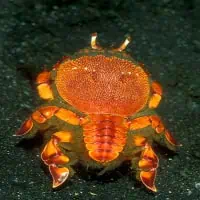
|
Spanner Crab |
SIZE: 0.15 m RARITY: Common BEHAVIOR: Fearful |
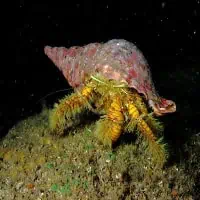
|
Hairy-Yellow Hermit Crab |
SIZE: 0.12 m RARITY: Common BEHAVIOR: Fearful |
Bivalves
Bivalvia, in previous centuries referred to as the Lamellibranchiata and Pelecypoda, is a class of marine and freshwater molluscs that have laterally compressed bodies enclosed by a shell consisting of two hinged parts. Bivalves as a group have no head and they lack some usual molluscan organs like the radula and the odontophore. They include the clams, oysters, cockles, mussels, scallops, and numerous other families that live in saltwater, as well as a number of families that live in freshwater.
| Image | Name | Details |
|---|---|---|
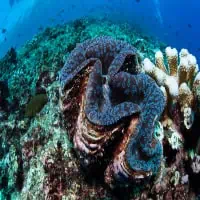
|
Giant Clam |
RARITY: Rare ASSOCIATION: Symbiosis AGE: 100 Years |
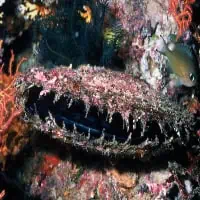
|
Black-lip-Pearl Oyster | RARITY: Common |
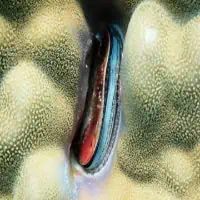
|
Coral Scallop | RARITY: Common |
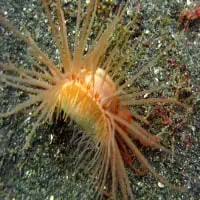
|
Oriental-Fire Clam | RARITY: Rare |
Gastropods
The gastropods, commonly known as snails and slugs, belong to a large taxonomic class of invertebrates within the phylum Mollusca called Gastropoda. This class comprises snails and slugs from saltwater, from freshwater, and from the land. There are many thousands of species of sea snails and slugs, as well as freshwater snails, freshwater limpets, and land snails and slugs.
| Image | Name | Details |
|---|---|---|
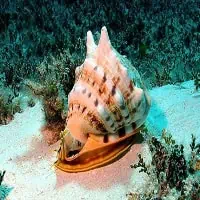
|
Horned Helmet |
SIZE: 0.40 m RARITY: Uncommon |
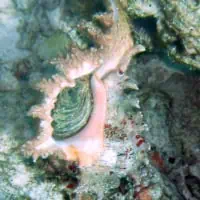
|
Rose-branch Murex | SIZE: 0.13 m RARITY: Common |
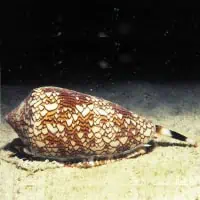
|
Textile Crone Shell |
SIZE: 0.15 m RARITY: Rare DANGEROUSNESS: Spine / Lethal |
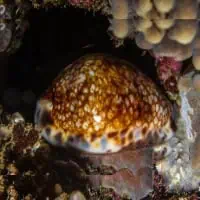
|
Map Crowie | SIZE: 0.10 m RARITY: Rare |
Nudibranchs
Nudibranchs are a group of soft-bodied, marine gastropod molluscs which shed their shells after their larval stage. They are noted for their often extraordinary colours and striking forms, and they have been given colourful nicknames to match, such as "clown," "marigold," "splendid," "dancer," "dragon," or "sea rabbit." Currently, about 3,000 valid species of nudibranchs are known.
| Image | Name | Details |
|---|---|---|
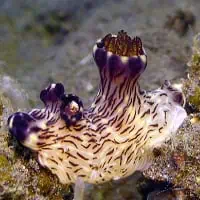
|
Red-lined Jorunna | SIZE: 0.30 m RARITY: Rare |
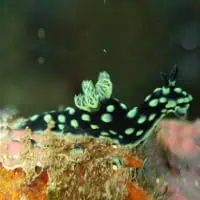
|
Black and Green Sea-Slug |
SIZE: 0.12 m RARITY: Uncommon |
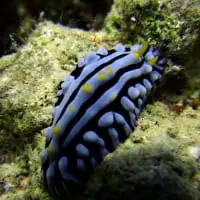
|
Varicose Wart-Slug | SIZE: 0.11 m RARITY: Rare |
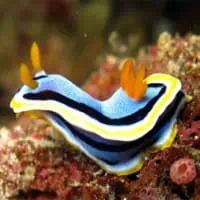
|
Annas Chromodoris |
SIZE: 0.05 m RARITY: Uncommon |
Cephalopods
Most sea cucumbers, as their name suggests, have a soft and cylindrical body, more or less lengthened, rounded off and occasionally fat in the extremities, and generally without solid appendages. Their shape ranges from almost spherical for "sea apples" (genus Pseudocolochirus) to serpent-like for Apodida or the classic sausage-shape, while others resemble caterpillars.
| Image | Name | Details |
|---|---|---|
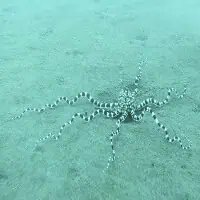
|
Mimic Octopus | SIZE: 0.60 m RARITY: Rare |
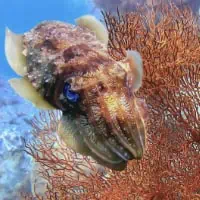
|
Broadclub Cuttlefish |
SIZE: 0.50 m RARITY: Uncommon |
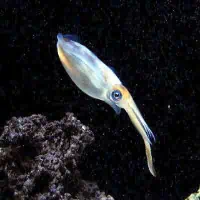
|
Bigfin Reef Squid | SIZE: 0.45 m RARITY: Common |
Sea Cucambers
A cephalopod is any member of the molluscan class Cephalopoda (Greek plural κεφαλόποδες, kephalópodes; "head-feet") such as a squid, octopus, or nautilus. These exclusively marine animals are characterized by bilateral body symmetry, a prominent head, and a set of arms or tentacles (muscular hydrostats) modified from the primitive molluscan foot. Fishermen sometimes call cephalopods "inkfish," referring to their common ability to squirt ink.
| Image | Name | Details |
|---|---|---|
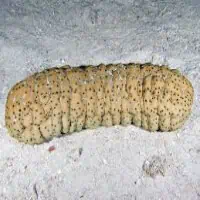
|
Curryfish Sea-Cucumber |
SIZE: 0.60 m RARITY: Uncommon |
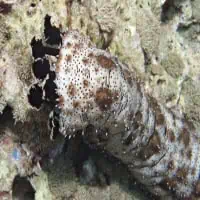
|
Black-Spotted Sea-Cucumber |
SIZE: 0.70 m RARITY: Uncommon |
Urchins
Sea urchins, are typically spiny, globular animals, echinoderms in the class Echinoidea. About 950 species live on the seabed, inhabiting all oceans and depth zones from the intertidal to 5,000 metres. Their tests (hard shells) are round and spiny, typically from 3 to 10 cm across. Sea urchins move slowly, crawling with their tube feet, and sometimes pushing themselves with their spines. They feed primarily on algae but also eat slow-moving or sessile animals.
| Image | Name | Details |
|---|---|---|
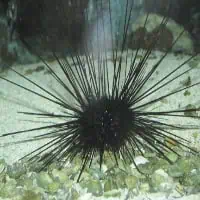
|
Diadem Urchin |
SIZE: 0.60 m RARITY: Common DANGEROUSNESS: Spine |
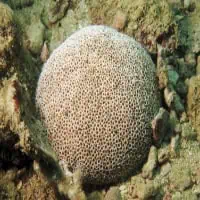
|
Flower Urchin |
SIZE: 0.15 m RARITY: Common DANGEROUSNESS: Spine / Lethal |
Sea Stars
Starfish or sea stars are star-shaped echinoderms belonging to the class Asteroidea. Common usage frequently finds these names being also applied to ophiuroids, which are correctly referred to as brittle stars or basket stars. Starfish are also known as Asteroids due to being in the class Asteroidea. About 1,500 species of starfish occur on the seabed in all the world's oceans, from the tropics to frigid polar waters.
| Image | Name | Details |
|---|---|---|
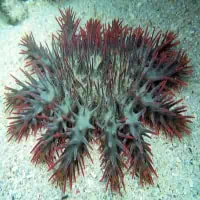
|
Crown-of-Thornes Starfish |
SIZE: 0.50 m RARITY: Uncommon DANGEROUSNESS: Spine |
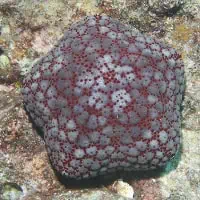
|
Cushion Starfish |
SIZE: 0.30 m RARITY: Uncommon |
Worms
Pseudoceros ferrugineus can reach a length of about 18–48 mm. It has an enlarged oval shape. The upper surface of the body is fuchsia (hence the common name) with small white dots and two marginal bands red and orange without dots
| Image | Name | Details |
|---|---|---|
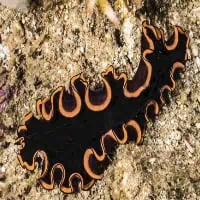
|
Hymans flatworm |
SIZE: 0.07 m RARITY: Uncommon |
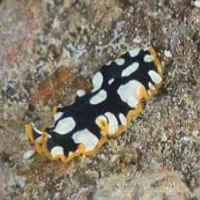
|
Brilliant flatworm |
SIZE: 0.06 m RARITY: Uncommon |
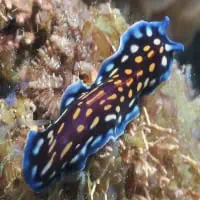
|
Lindas flatworm |
SIZE: 0.06 m RARITY: Uncommon |
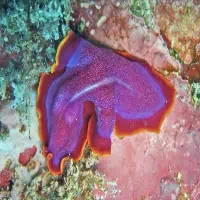
|
Fuchsa flatworm |
SIZE: 0.06 m RARITY: Uncommon |
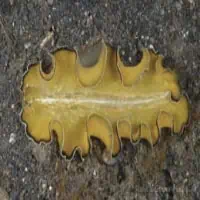
|
Flowers flatworm |
SIZE: 0.04 m RARITY: Uncommon |
Worms-2
Sabellidae, or feather duster worms, are a family of marine polychaete tube worms characterized by protruding feathery branchiae. Sabellids build tubes out of a tough, parchment-like exudate, strengthened with sand and bits of shell. Unlike the other sabellids, the genus Glomerula secretes a tube of calcium carbonate instead. Sabellidae can be found in subtidal habitats around the world. Their oldest fossils are known from the Early Jurassic.
| Image | Name | Details |
|---|---|---|
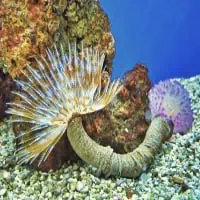
|
Feather-Duster Worm | SIZE: 0.04 m RARITY: Common |
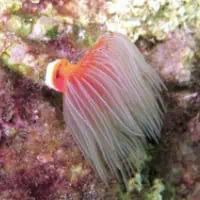
|
Red Fanworm | SIZE: 0.06 m RARITY: Common |
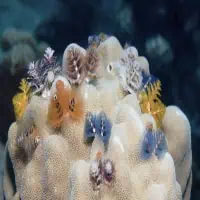
|
Christmas-tree Worms | SIZE: 0.04 m RARITY: Common |
Branching Corals
Stony corals are members of the class Anthozoa and like other members of the group, do not have a medusa stage in their life cycle. The individual animals are known as polyps and have a cylindrical body crowned by an oral disc surrounded by a ring of tentacles. The base of the polyp secretes the stony material from which the coral skeleton is formed.
| Image | Name | Details |
|---|---|---|
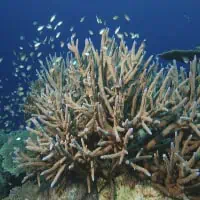
|
Great Staghorn Coral | SIZE: 7.00 m RARITY: Common |
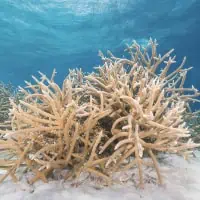
|
Staghorn Coral |
SIZE: 1.50 m RARITY: Common VULNERABILITY: Threatened |
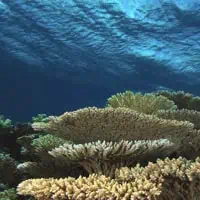
|
Robust Table-coral | SIZE: 1.20 m RARITY: Common |
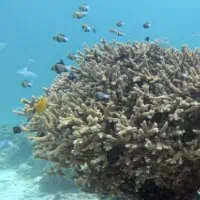
|
Wide Star Acropora | SIZE: 0.80 m RARITY: Common |
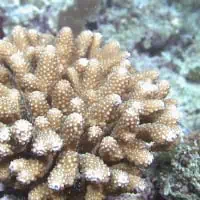
|
Finger Acropora | SIZE: 0.60 m RARITY: Common |
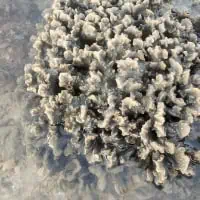
|
Sandpaper Coral | SIZE: 2.50 m RARITY: Common |
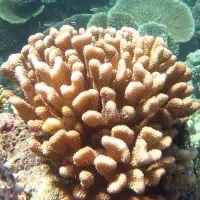
|
Antler Coral |
SIZE: 1.00 m RARITY: Common VULNERABILITY: Threatened |
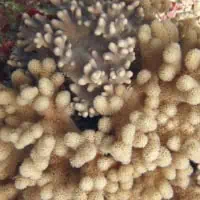
|
Juweled Finger Coral |
SIZE: 1.00 m RARITY: Common VULNERABILITY: Threatened |
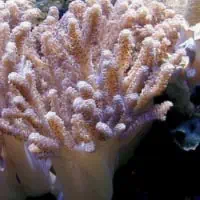
|
Finger Coral | SIZE: 0.50 m RARITY: Common |
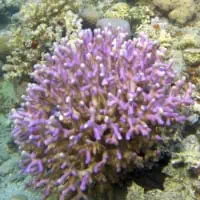
|
Finger Coral | SIZE: 0.30 m RARITY: Common |
Massive- & Brain Corals
| Image | Name | Details |
|---|---|---|
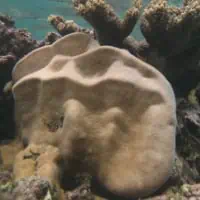
|
Knob Coral | SIZE: 1.00 m RARITY: Common |
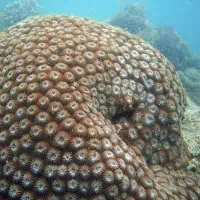
|
Honeycomb Coral |
SIZE: 1.50 m RARITY: Common VULNERABILITY: Threatened |
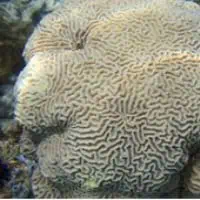
|
Head Coral | SIZE: 1.00 m RARITY: Common |
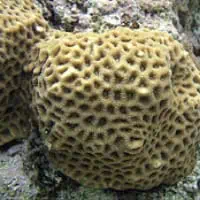
|
Flexus Moon Coral |
SIZE: 1.20 m RARITY: Common VULNERABILITY: Threatened |
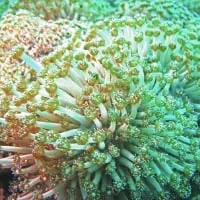
|
Columna Goniopora |
SIZE: 0.60 m RARITY: Common VULNERABILITY: Threatened |
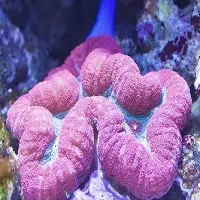
|
Lobed Brain Coral | SIZE: 5.00 m RARITY: Common |

|
Bubble Coral |
SIZE: 2.00 m RARITY: Uncommon VULNERABILITY: Threatened |
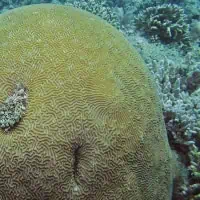
|
Net Brain Coral | SIZE: 1.00 m RARITY: Common |
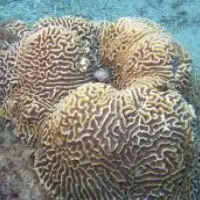
|
Australian Brain Coral | SIZE: 2.00 m RARITY: Common |
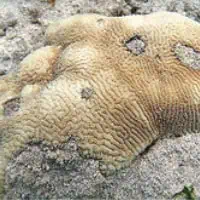
|
Closed Brain Coral |
SIZE: 1.50 m RARITY: Common VULNERABILITY: Threatened |
Leaf-, Mushroom & Hydros-, Flower Corals
| Image | Name | Details |
|---|---|---|
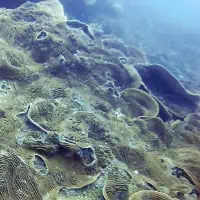
|
Rough pachyseris | SIZE: 8.00 m RARITY: Common |
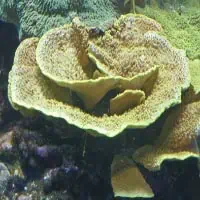
|
Leafy Cub Coral |
SIZE: 3.00 m RARITY: Plenty VULNERABILITY: Threatened |
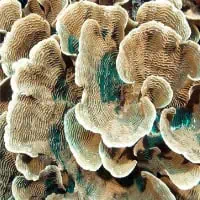
|
Elepant-skin Coral | SIZE: 2.00 m RARITY: Common |
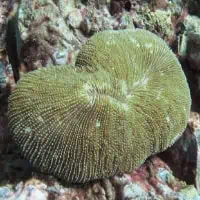
|
Mushroom Coral | SIZE: 0.30 m RARITY: Common |
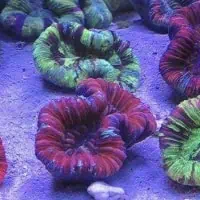
|
Open brain Coral |
SIZE: 0.20 m RARITY: Uncommon VULNERABILITY: Threatened |
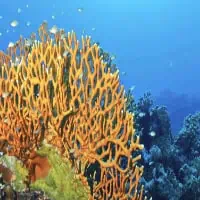
|
Fire Coral | SIZE: 1.00 m RARITY: Common |
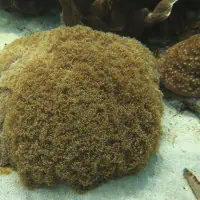
|
Anchor Coral |
SIZE: 1.00 m RARITY: Uncommon VULNERABILITY: Threatened |
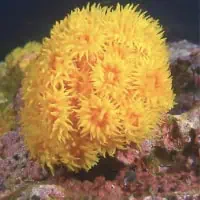
|
Orange Cup Coral |
SIZE: 0.35 m RARITY: Uncommon |
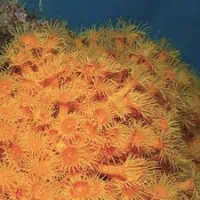
|
Yellow Commensal Anemon |
SIZE: 0.30 m RARITY: Uncommon |
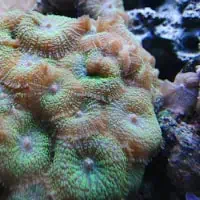
|
Mushroom Anemone | SIZE: m RARITY: Common |
Sea Fans & Anemones
| Image | Name | Details |
|---|---|---|
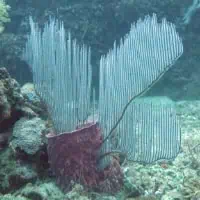
|
Lyre Sea Fan |
SIZE: 1.50 m RARITY: Uncommon |
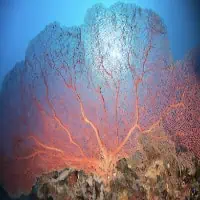
|
Giant Sea Fan |
SIZE: 2.00 m RARITY: Uncommon |
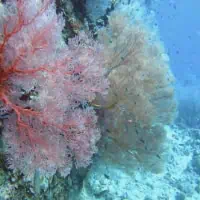
|
Knotted Fan Coral |
SIZE: 1.00 m RARITY: Uncommon |
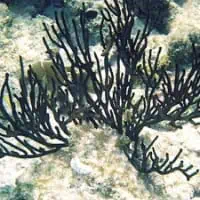
|
Black Coral | SIZE: 3.00 m RARITY: Rare |
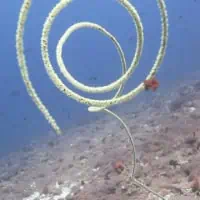
|
Spiral Wire Coral | SIZE: 2.00 m RARITY: Common |
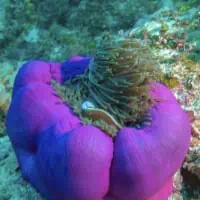
|
Magnificient Sea Anemone | SIZE: 1.00 m RARITY: Common |
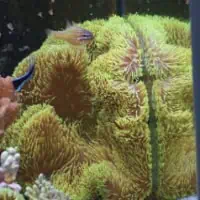
|
Giant Carpet Anemone | SIZE: 1.20 m RARITY: Common |
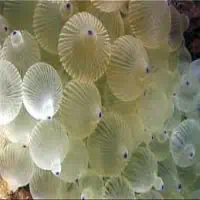
|
Bulb-tentacle sea anemone | SIZE: 0.40 m RARITY: Common |
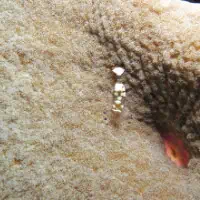
|
Pizza Sea Anemone |
SIZE: 0.35 m RARITY: Uncommon |
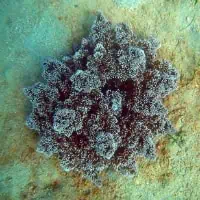
|
Stout Hells-fire Anemone | SIZE: 0.50 m RARITY: Rare |
Soft Corals & Jellyfish
| Image | Name | Details |
|---|---|---|
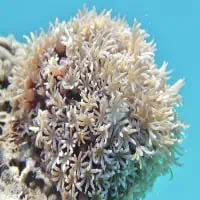
|
Organ Pipe Coral | SIZE: 1,00m RARITY: Uncommon |
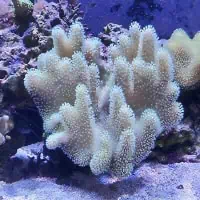
|
Leather Coral | SIZE: 0,80m RARITY: Plenty |
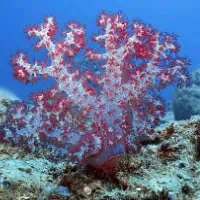
|
Carnation Tree Coral | SIZE: 0,70m RARITY: Plenty |
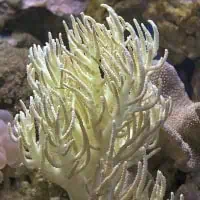
|
Flexible Leather Coral | SIZE: 0,50m RARITY: Plenty |
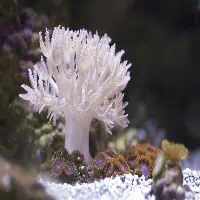
|
Pulsing Coral | SIZE: 0,20m RARITY: Uncommon |
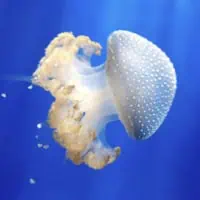
|
Spotted Jelly |
SIZE: 3,00m RARITY: Rare DANGEROUSNESS: Urticant |
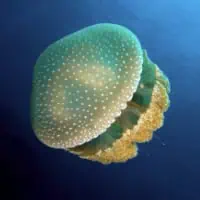
|
Australian Spotted Jellyfish |
SIZE: 0,70m RARITY: Uncommon DANGEROUSNESS: Urticant |
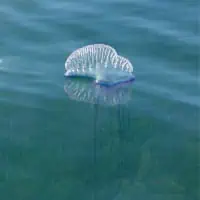
|
Portoguese Man-of-War |
SIZE: 0,20m RARITY: Rare DANGEROUSNESS: Urticant/Lethal |
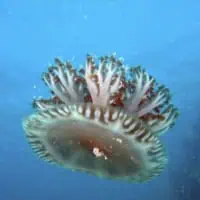
|
Upside-down Jellyfish |
SIZE: 0,30m RARITY: Uncommon DANGEROUSNESS: Urticant |
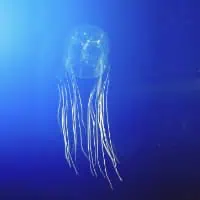
|
Australian Box-jellyfish |
SIZE: 4,00m RARITY: Rare DANGEROUSNESS: Urticant/Lethal |
Tube-, Vase-, Branching- & Massive Sponges
| Image | Name | Details |
|---|---|---|
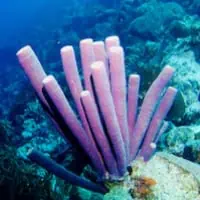
|
Liliac Tube-sponge |
SIZE: 0.80 m RARITY: Uncommon |
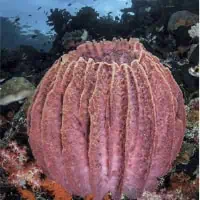
|
Barrel Sponge | SIZE: 2.00 m RARITY: Plenty |
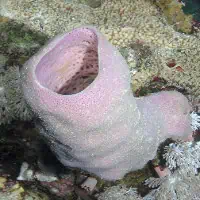
|
Large Tube-sponge |
SIZE: 0.80 m RARITY: Uncommon |
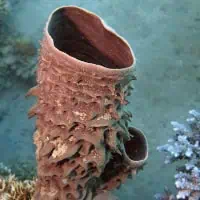
|
Prickly Tube-sponge |
SIZE: 0.50 m RARITY: Uncommon |
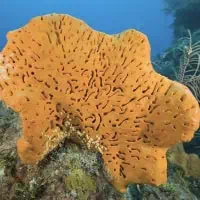
|
Elephant ear sponge | SIZE: 2.00 m RARITY: Common |
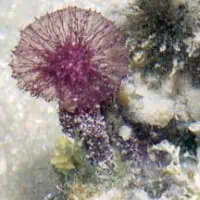
|
Pink Puff Ball Sponge | SIZE: 0.10 m RARITY: Rare |
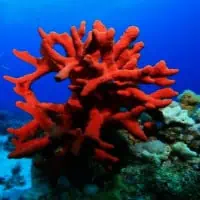
|
Red Finger Sponge | SIZE: 0.70 m RARITY: Common |
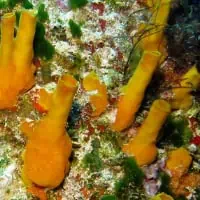
|
Vagabound Boring Sponge | SIZE: 1.00 m RARITY: Common |
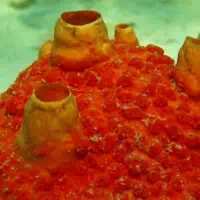
|
Red Boring Sponge |
SIZE: 1.00 m RARITY: Uncommon |
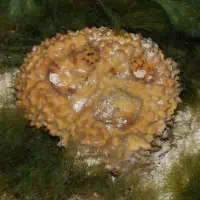
|
Yellow Pot Sponge | SIZE: 0.30 m RARITY: Common |

